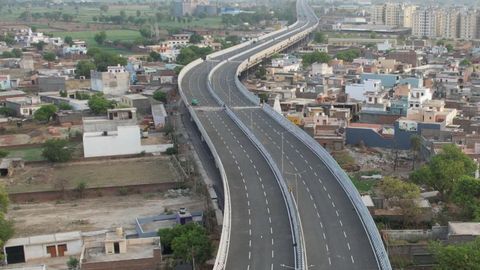
A 3.5 km section of the 201 km Delhi-Dehradun Expressway, linking Daat Kali to Asharodi, has been opened to the public, with all six lanes now operational. This segment is part of Asia’s longest wildlife highway corridor, designed to allow animals such as elephants to roam safely beneath the roadway.
The newly opened stretch constitutes a vital part of the expressway’s first phase, which extends 31.6 km from Akshardham in Delhi to Khekra in Baghpat. Once fully operational, the expressway will include 113 underpasses, five railway overbridges (ROBs), and 62 bus shelters, traversing Shastri Park, Khajuri Khas, Mandola Baghpat, Khekda Shamli, and Saharanpur before arriving in Dehradun.
Also, read our story on Humayunpur, a slice of Northeast India in Delhi’s Safdarjung Enclave.
Delhi-Dehradun Expressway: A landmark wildlife corridor
The upcoming 6-lane access-controlled greenfield economic corridor, spanning 210 km, is set to offer uninterrupted connectivity from #Delhi to #Dehradun. Here are some glimpses of its construction in full swing #NHAI #HighwaysofGrowth #BuildingANation pic.twitter.com/W6vet5jD7C
— NHAI (@NHAI_Official) December 13, 2023
The Delhi-Dehradun Expressway features Asia’s longest wildlife corridor, an impressive 12-kilometre elevated stretch currently under construction within Rajaji National Park. This corridor aims to safeguard wildlife while significantly reducing travel time.
The expressway is being constructed in three phases, with a focus on the areas between Delhi, Dehradun, and Saharanpur. The signage, expansion joints, and infrastructure for phase one are nearly complete, boasting a progress rate of 90-95 percent. Under this scheme, a 2.3 km tunnel will minimise disruption, enabling vehicular movement and environmental harmony to coexist.
The Delhi-Dehradun Greenfield Access Controlled Expressway, developed at INR 12,000 crore, will facilitate toll-free travel for 18 km of the route from Akshardham to Loni.
The expressway will also feature numerous foot over-bridges, allowing pedestrians to cross the road with ease while not disrupting the moving traffic.
Delhi-Dehradun Expressway Is Now Open: Check Travel Time, Why It’s Toll-Free And Morehttps://t.co/KxxQdj7xgt pic.twitter.com/iHhNAaIC7G
— NDTV (@ndtv) February 6, 2025
The elevated section between Shastri Nagar and Loni in Delhi is intended to ease traffic congestion in densely populated areas such as Mandola, Panchgaon, Khajuri Khaas, and Geeta Colony.
In addition to reducing travel time between Delhi and Dehradun, this expressway will enable travellers from Delhi to reach Haridwar in just two hours. The expressway will connect Delhi’s Akshardham to Uttarakhand’s Dehradun via cities such as Saharanpur, Bhagpat, Shamli, and Ghaziabad.
The final 20-kilometre stretch of this corridor traverses the eco-sensitive zone of Rajaji National Park, where construction is underway. This section will feature a 340-metre Daat Kali tunnel alongside the elevated corridor, both designed to safeguard the surrounding wildlife.
The project is significant, as it reduces travel time between the national capital and a major city in Uttarakhand, enabling travellers to enjoy quick getaways to destinations around Delhi, such as Mussoorie, Kanatal, and others. This will also help to boost trade and tourism in the region by providing enhanced connectivity.
The expressway will also connect with other major highways and expressways, including the Eastern Peripheral Expressway, Delhi-Meerut Expressway, Saharanpur-Roorkee-Haridwar, and Ambala-Shamli Expressway.
(Feature image credit: @NHAI_Official/X)
Related: Weekend Getaways Near Delhi Within 500 km That Will Make For An Ideal Road Trip
The information in this article is accurate as of the date of publication.












